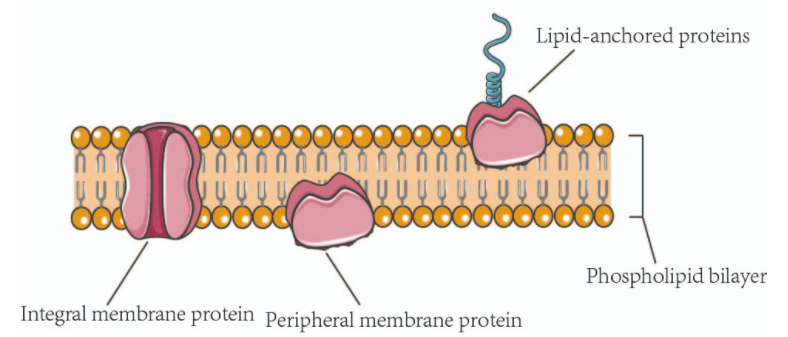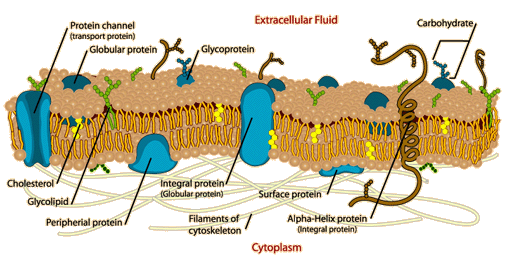Membrane Proteins Study Guide
Check out awesome, educational VR rooms on Inspirit’s mobile app (available for iOS and Android devices)🤩
Introduction
All biological functions rely on membrane proteins. Cells can’t operate without them since they are built up of amino acids. ‘Lys’ and ‘Arg’ are two kinds of interfering amino acids that sit on the membrane surface and may dip into the bilayer of interfacial proteins. There are extensive regions of integral proteins implanted in the middle layer of the membrane that are permanently attached to it.
Molecules and ions need transmembrane proteins to travel across the membrane. A wide variety of essential cellular processes are mediated by membrane proteins found in every cell. They aid in cell communication, shape maintenance, and chemical messenger-induced transformation. Also, they have a significant impact on how fast a disease develops.
The immune system makes use of them to identify foreign substances. The fundamentals of membrane proteins will be covered in this article.
What are membrane proteins?
Membrane proteins are typical proteins found in biological membranes. They are involved in the function of the biological membrane and are divided into numerous types. Membrane proteins might be integral or non-essential depending on where they are found. They may be found in several settings, including cell and tissue membranes, cell walls, and liver membranes. Here are some examples of membrane proteins.
Some membranes are extremely specialized, having more than 70% protein. Human nerve cells, for example, contain less than 20% protein. The cell’s inside and outside are filled with liquid, a solution of ions, and tiny and big molecules. Because proteins must be hydrophilic to be suspended in liquid, they are often classed as phospholipids. The hydrocarbon tails of these lipids point toward the structure’s core.
In addition to being integral proteins, membrane proteins contain a structural motif that is shared by all proteins. The a-helix has 20 amino acids, each of which spans 1.5 A. These are often devoid of polar amino acids, so they are referred to as transmembrane proteins. On the other hand, polar amino acids are often located in the protein’s non membrane regions, which we refer to as the a-helix.

Integral membrane proteins are proteins that are irreversibly attached to the plasma membrane. They are accountable for a wide variety of critical activities. Membranes provide several roles, including channeling and transporting molecules across their surfaces. Along with structural functions, numerous proteins act as cell receptors. Based on their interaction with the bilayer, types of membrane proteins and integral membrane proteins are categorized into three groups:
-
Transmembrane proteins are proteins that can cross the whole plasma membrane. Transmembrane proteins may be found in any biological membrane, including cell membranes. These are integrally monotopic and have a single attachment site to the membrane.
-
Specific integral membrane proteins enhance cell adhesion (sticking a cell to another cell or surface). Carbohydrate chains are connected to particular proteins on the cell membrane’s surface to distinguish between distinct cell types.
-
Peripheral proteins are deemed peripheral protein-membrane. It is not required to function since it is just briefly linked to the membrane. Elimination of them indicates that they are involved in cell signaling. Peripheral proteins may occupy a tiny piece of the lipid bilayer on their own or by association with integral membrane proteins. Such proteins in the periphery often coexist with ion channels and transmembrane receptors. The overwhelming majority of membrane proteins in the boundary have a water-loving nature.
Functions of Membrane Proteins
- They can serve as receptors. Lipid insoluble signal molecules cannot pass through the membrane. The relay their signal to the membrane receptors which in turn transmits it to the interior of the cell. For example α1 receptors of adrenaline is smooth muscles of arterioles. By stimulating this receptor adrenaline, orders the cells to contract.
- Adhesion molecules. Some proteins form physical contact with the surrounding extracellular matrix or with neighboring cells. For example integrins attach the cell to the extracellular matrix and cadherins make cell to cell contacts.
- To carry out transmembrane movement. These are various transport proteins. They contribute to movement of water and water soluble substances across the membrane. For example Na channels in the neuron allow the passage of Na when it is stimulated. In such channels amino acids towards the center of the channels are polar. They can stay in contact with water whereas amino acids on the outer are non-polar so they stay with non-polar lipids of the membrane.
- They can function as enzymes. For example various enzymes on luminal side of intestinal cells. They breakdown small polysaccharides into single sugars and small polypeptides into singe amino acids.
- They contribute in Intracellular signaling. For example G proteins. They associate with G protein coupled receptors and participate in signal transduction.
The Fluid Mosaic Model
The fluid mosaic model of cell membrane structure was suggested by SJ Singer and G.L. Nicolson in 1972. The image depicts phospholipid bilayer integration of membrane proteins shown in Figure 1. Some may or may not pass through the bilayer fully, depending on the protein. Proteins are found in membranes that function as transporters or receptors. Rather than being solid, the membrane is fluid in its estimation. Membrane proteins and lipids float in the water like buoys. As a result, the ‘mosaic pattern’ of the cell membrane is continually changing.Cell Membrane Extensions

The presence of membrane extensions, such as whip-like flagella or brush-like cilia, may be used to identify cell types. Single-celled organisms’ membrane extensions may help the microbes migrate. The extensions of multicellular animals may perform many different roles. The cilia on the surface of human lung cells, for example, whisk away foreign particles and mucus from the mouth and nose when stimulated.
Conclusion:
- Membrane proteins are often found on the surface of cells or inside organelles. To mention a few, integral Membrane proteins include receptors and ion channels.
- The Fluid Mosaic Model reveals the inner workings of the plasma membrane.
- Peripheral Membrane proteins, such as signaling proteins, are attached by a fatty acid, phenyl group, glycophosphatidylinositol (GPI), or hydrophobic protein patch.
- Cilia and flagella, which protrude from a cell’s plasma membrane, help in movement.
- Membranes arise when lipids and proteins combine to form a barrier between cells and intracellular organelles. Only certain molecules may pass across membranes, separating the outside from the inside and conveying information through a series of chemical reactions.
FAQs:
1. What is the classification of membrane proteins?
Membrane proteins can be classified as either integral or intrinsic depending on their function. Integral proteins form water-filled channels, while uniporters transport one molecule at a time across the cell’s membrane. Both types are essential to cell life. What differentiates them is their ability to transport various molecules across the cell’s membrane.
2. What are the seven membrane proteins?
- Protein Receptor
- Adhesion Protein
- Anchor Protein
- Enzyme
- Glycoprotein
- Protein distribution
- Protein Carrier
3. What are the four types of membrane proteins?
The outer leaflet has a noncovalent bond with an extrinsic membrane protein that forms a hydrogen bond with another part of the membrane. There are four types of Membrane proteins: lipid-anchored, integral, peripheral, and auxiliary. The former is only temporarily attached to the membrane, whereas the latter is permanently attached.
4. What are membrane proteins, and what do they do?
Membrane proteins, including transmembrane proteins, are referred to by this term. These molecules are indistinguishable from other proteins because they are permanently attached to a biological membrane. Membrane proteins are divided into joining, integral, and peripheral categories. A necessary membrane protein is permanently attached to a cell’s membrane, whereas a peripheral membrane protein is loosely attached.
5. What are the five types of membrane proteins?
- Transport-proteins
- Enzymes
- Signal-transduction proteins
- Recognition-proteins
- Joining-proteins
6. What are the different types of membrane proteins?
Proteins that interact with or are part of the membranes of living organisms are known as membrane-associated proteins. They are attached to the cell membrane for a brief time. Proteins found on membranes may be categorized regionally. One side of a membrane (integral) may be penetrated by a transmembrane protein (integral monotopic).
7. What are the three functions of membrane proteins?
Junctions – Junctions are used to link and unite two or more cells.Enzymes – The binding of enzymes to membranes helps to localize metabolic processes.Transport – Is in charge of aided dissemination as well as active transportation.
We hope you enjoyed studying this lesson and learned something remarkable about Membrane Proteins! Join our Discord community to get any questions you may have answered and to engage with other students just like you! Don’t forget to download our App and check out our excellent VR room for this guide – we promise it makes studying much more fun! 😎
]]>